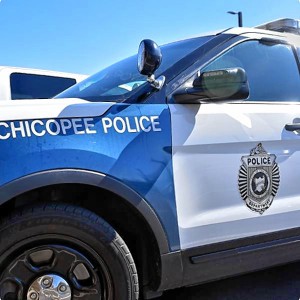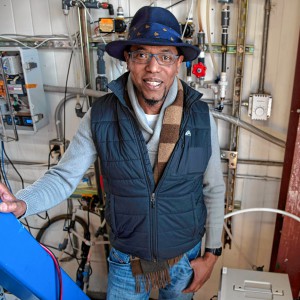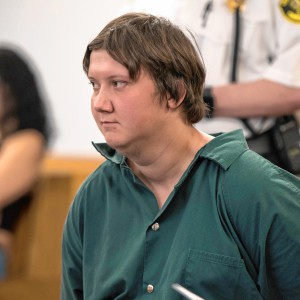Accused takes stand in fatal overdose trial
| Published: 05-25-2017 7:10 PM |
NORTHAMPTON — For over two hours Thursday, a former University of Massachusetts graduate student took the stand detailing his heroin addiction and the role he played in the overdose death of an undergraduate in 2013.
Day two of the trial of Jesse Carrillo, 28, began Thursday morning in Hampshire Superior Court with testimony from officials who investigated the case. By mid-morning, Carrillo himself took the stand detailing his history with drugs.
Carrillo pleaded not guilty in October 2015 to involuntary manslaughter and distributing heroin. He allegedly provided heroin to Eric L. Sinacori, who was found dead from an overdose by his father in his off-campus apartment at Puffton Village in Amherst on Oct. 4, 2013.
Sinacori, 20, of Whitehouse Station, New Jersey, was a third-year kinesiology major at UMass. His death came 10 months after he became a confidential informant for a now-defunct program with the University of Massachusetts Police Department. The confidential informant program ended in January 2015 following news reports and a university review.
Through questioning by his attorney, J.W. Carney Jr., Carrillo told the jury the first time he tried heroin was during his first year of graduate school while home for winter break. A friend who had introduced him to marijuana when he was 12 years old offered to shoot him up for the first time in January 2013.
“I’m not proud of it but it was the best thing I had ever felt in my life at that point and I just wanted to do it again,” Carrillo said of his first time.
Through friends, Carrillo made contact with a drug trafficker in the Bronx and started to purchase heroin directly from him. During the 10 months Carrillo was using heroin, he said he “can’t put even an estimate” on how much he consumed.
By September 2013, Carrillo said, he had a “full-blown heroin addiction,” with the drug dominating his thoughts.
Article continues after...
Yesterday's Most Read Articles
 South Hadley’s Lauren Marjanski signs National Letter of Intent to play soccer at Siena College
South Hadley’s Lauren Marjanski signs National Letter of Intent to play soccer at Siena College
 LightHouse Holyoke to buy Gateway City Arts, expand offerings and enrollment at alternative school
LightHouse Holyoke to buy Gateway City Arts, expand offerings and enrollment at alternative school
 Treehouse, Big Brothers Big Sisters turn race schedule snafu into positive
Treehouse, Big Brothers Big Sisters turn race schedule snafu into positive
 South Hadley man fatally shot in attempted robbery
South Hadley man fatally shot in attempted robbery
 Granby man admits guilt, gets 2½ years in vehicular homicide
Granby man admits guilt, gets 2½ years in vehicular homicide
 Area briefs: Transhealth to celebrate 3 year; Holyoke to plant tree at museum; Documentary film about reparations focus of Unitarian talk
Area briefs: Transhealth to celebrate 3 year; Holyoke to plant tree at museum; Documentary film about reparations focus of Unitarian talk
“It was terror,” he said. “I tried really hard to be a student and a heroin addict at the same time. I tried, I struggled and I failed.”
Carrillo’s testimony then turned to text messages he exchanged with Sinacori in the week leading up to his death.
The first message came on Sept. 30, 2013, and in it, Sinacori introduced himself to Carrillo, referencing a fellow acquaintance and asking if Carrillo was making a “run” soon.
On Oct. 1, the two were in contact again.
“Eric sent you a message saying, ‘I’ll probably cop on the regular if I like it again,” Assistant Northwestern District Attorney Jeremy Bucci read. “How did you interpret that?”
“That he would consistently purchase the heroin for himself if he likes it,” Carrillo replied.
“Through you?” Bucci asked.
“Yes, but for himself,” Carrillo replied.
When Carrillo returned to Amherst from the Bronx, he said the two spent about 10 minutes together shooting up before Sinacori returned to his own apartment.
Two days later, Sinacori reached out to Carrillo asking him if he was making another “run” to the Bronx.
“I interpreted it as if he was approaching me because he wanted more heroin for himself,” Carrillo said.
Returning from his trip to the Bronx on Oct. 3, Carrillo gave Sinacori nine bags of heroin as he only received $90 from Sinacori.
“I gave Eric his heroin. It was very brief, maybe a minute,” Carrillo said. “I went into my apartment, he again, presumably, went to his apartment.”
Carrillo said he sent Sinacori two messages, out of “curiosity” but didn’t think anything of Sinacori not responding.
Learning about Sinacori’s death a few days later via a campus email, Carrillo said, after a long pause, it made him “very sad.”
When asked why he didn’t go to police, he responded “that wouldn’t have been able to bring him back.”
“He was gone and there was nothing I could do,” Carrillo said.
Earlier in the day, the prosecution called two police officers, the forensic scientist in the post-mortem toxicology unit in the Massachusetts State Police crime lab, the medical examiner and the chemist involved in the case.
Forensic scientist Jessica Gleba testified that no fentanyl was found in Sinacori’s blood but a toxicology screen found a small amount of benzodiazepines, specifically aprazolam (Xanax), and THC.
Dr. Andrew Sexton, of the state medical examiner’s office, testified that on the outside, Sinacori looked like a healthy young college student except for injection sites on the crook of his right arm and a mark on his forehead.
“Cause and manner of death was due to the heroin,” Sexton said. “Acute heroin intoxication.”
Referencing a 2016 report published by the Massachusetts Department of Health, Carney said researchers concluded that benzodiazepines were present in 58 percent of opioid deaths.
Citing Google searches taken from Sinacori’s death by police after his passing, Carney asked Sexton about “potentiate,” which Sexton said would mean in a “pharmaceutical sense that two drugs would have a combined effect and would have an enhanced response.”
In consulting with the toxicologist, Sexton said he asked why there was no “quantitative” test done on the benzodiazepines, and was told the level was too low to be quantified — a factor, Sexton confirmed, that was significant in making his decision on cause of death.
Asked by Bucci if substances stop metabolizing upon death, Sexton said they do, with the exception of cocaine. When pressed by Bucci if benzodiazepines continue to metabolize after death, Sexton responded “not to my knowledge.”
Defense counsel is expected to call at least two more witnesses Friday morning. The case is likely to go the jury later in the day.
Emily Cutts can be reached at ecutts@gazettenet.com.

 Advancing water treatment: UMass startup Elateq Inc. wins state grant to deploy new technology
Advancing water treatment: UMass startup Elateq Inc. wins state grant to deploy new technology New Realtor Association CEO looks to work collaboratively to maximize housing options
New Realtor Association CEO looks to work collaboratively to maximize housing options Northampton man will go to trial on first-degree murder charge after plea agreement talks break down
Northampton man will go to trial on first-degree murder charge after plea agreement talks break down  Area property deed transfers, April 25
Area property deed transfers, April 25
